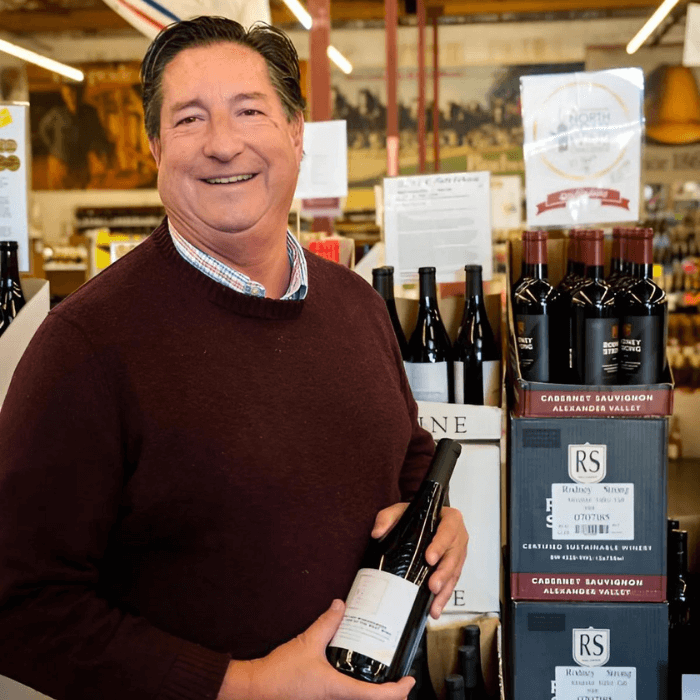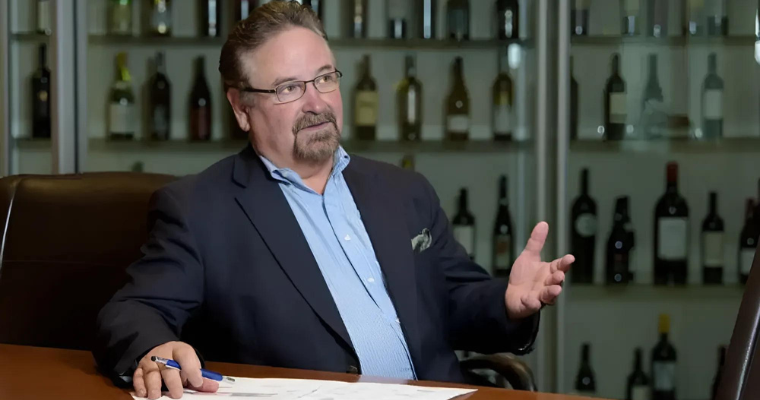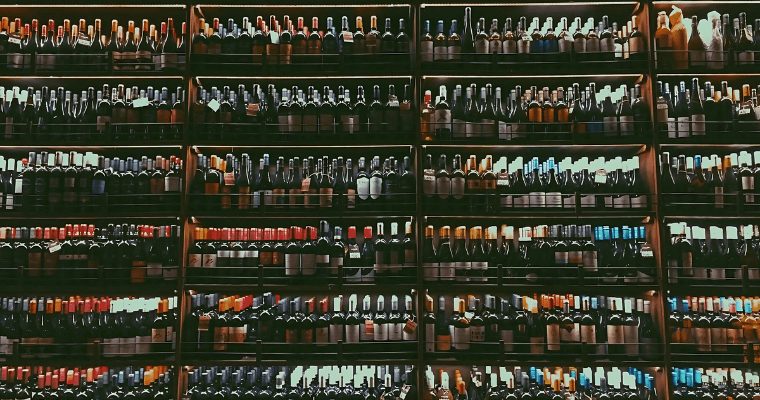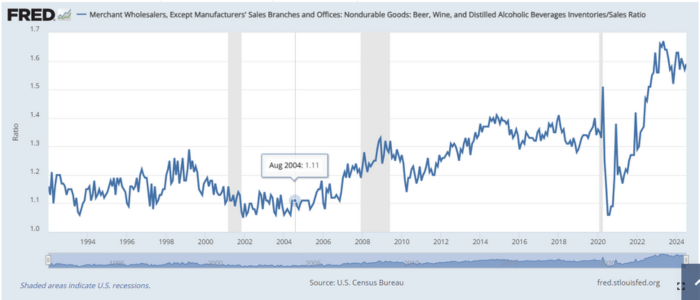Warehouse
Open from Jan 1st - July 10th 2026
Judging
Date
July 27, 2026
Winners
Announced
August 12, 2026

The wholesale wine market lies amidst a huge transformation. Consolidation among distributors, the rise of private-label brands, and shifting consumer preferences have reshaped how wine producers, both domestic and international, bring products to the American market. While large producers may have the resources to navigate these changes, small and medium-sized wineries face mounting challenges as they struggle to compete for distribution and shelf space. This situation also affects independent wine retailers.

Barry Herbst of Bottle Barn; source: The Oak Leaf
At the heart of any issue facing winemakers is the vastly decreasing number of U.S. distributors. Today, three major players—Southern Glazer's Wine and Spirits, Republic National, and Breakthru Beverage Group—dominate the landscape, limiting opportunities for smaller wineries. The annual Impact Databank Report from Shanken (which includes spirits sales) showed that Southern Glazer’s and RNDC together will control a projected 53% of the market in 2024. If we expand that to the top 10 companies, they will control a projected 81.5%. Barry Herbst, Wine Director at independent retailer Bottle Barn in Sonoma, summarizes that distribution is “greatly consolidated now. Fewer companies carrying more products in their books.” But there are many “products and services the big guys don't want to bother with.”
Southern Glazer’s, for example, represents more than 1,700 beverage suppliers, including more than 7,000 individual brands. There are, however, about 12,000 wineries in the US, many with multiple brands.

Rob McMillan; source: The Buyer
Rob McMillan of Silicon Valley Bank’s wine division explains the current situation: “Wine distribution continues to be stacked up in the warehouses.” This is affecting everyone involved, but not equally. “Larger premium wineries with good brands are getting their wine through to retailers and consumers while other wine inventory continues to linger.”
McMillan is not convinced that this situation will be resolved quickly. “There are occasional speeches that are made by the senior people in larger wholesalers and those in a few larger wineries as well, that they think the backlog will start to abate next year, or that we are on the precipice now. But thus far, the data aren’t supporting that.” He points to the graph pictured above. “At the peak, the backup in inventories was 1.67x sales in May 2023. Inventories have dropped through July 1st to 1.59x sales. That’s about a 5% drop in a little over a year. It’s progress, but that’s still a long way from historical averages.”
Glazer’s, for example, delivers weekly to more than 250,000 customers in 45 U.S. markets and Canada and has brokerage operations through its recently acquired WEBB Banks division in the Caribbean, Central and South America. This concentration in distribution means fewer options to get products into stores and restaurants, a situation that has worsened as many smaller wholesalers have been acquired or forced out of business.

Source: Unsplash
In addition, a 2024 White Paper by the National Association of Wine Retailers (NAWR) noted the critical issue of the antiquated nature of federal and state legislation. It addressed issues relevant after the end of Prohibition—the often-derided three-tier system. “The legally mandated use of a wholesaler imposed upon both producers and retailers has the effect of putting the wholesaler in the position of replacing the pre-prohibition brewer as the new coercive element within the alcohol industry” (emphasis added).

Inventories, including wine, beer, and spirits
The NAWR quoted a publication of the National Conference of State Liquor Administrators (the largest association of state alcohol regulation employees) from as long ago as 2010: “Under the typical three-tier system, retail establishments must purchase beverage alcohol products from wholesalers, not from manufacturers. It is now the wholesaler, as the seller of the product to the retailer, who has every bit as much incentive as the manufacturer to seek to induce preferential treatment by the retailer for the wholesaler’s products.” NAWR notes that in all but a few states, “the three-tier system with its legal mandate that producers sell to wholesalers and retailers buy from wholesalers remains the predominant form of alcohol control and regulation in the United States.”
According to data from the Alcohol and Tobacco Tax and Trade Bureau (TTB), around 115,000 new wine labels are approved annually, with a significant portion being imported. Despite the slightly reduced number of new labels since the pandemic, the competition to find distribution remains obviously fierce. The wholesale market, however, struggles to keep up with this influx of wines, particularly as independent wineries face increased difficulties in securing distribution deals. Another issue is that, as Wine-Searcher puts it, the industry is “awash with wine.”
This challenge is particularly acute for small and medium-sized wineries, both in the U.S. and abroad. The number of distributors has fallen drastically, and today fewer than 1,000 serve over 8,000 wineries in the U.S. alone. Mario Zepponi of BMO Commercial Bank’s wine division explained, "In the 1990s, there was more than one distributor per winery. Today, it’s the opposite—too many wineries, too few distributors." He blames the "insufficiency of the three-tier wholesale channel to meet the present-day needs of independent wineries," according to Wine-Searcher.

Nova Cadamatre MW; Source: novacadamtre.com/Autumn Layne Photography
For small wineries, this shrinking distribution network is especially concerning. These producers often rely on distributors to handle logistics and marketing, but the consolidation means that large distributors prioritize their most profitable accounts. Small wineries, which often lack the financial power to offer significant incentives to distributors, are being pushed out.
Nova Cadamatre MW, who operates Trestle Thirty-One winery in the Finger Lakes, says, “It is cutthroat for small producers. It’s challenging to even get a response [from distributors] sometimes. There were fewer brands 20 years ago so now the fight for the shelf space is even more challenging. Also, you can’t count on a distributor to sell your wines if you are a small producer sitting in a large book.” She concludes: “You have to do a lot of leg work yourself now.”
Moreover, the rise of private-label brands—wines that are created for and sold exclusively by retailers—has further diminished the space for independent producers. Retailers, especially large chains, favor these private labels due to their higher profit margins. For small wineries, this trend is squeezing them out of retail shelves and leaving them with few options to market their wines.
Cadamatre explains that “everyone knows that the real money is in volume. It is more profitable for a distributor to make a 4 pallet case stacked drop with one visit than it is to go to 15 different restaurants and sell 6 bottles each. Small producers don’t have the ability to compete on price and volume so we must show our worth in other ways that are often not as immediately tangible.”
International small producers face similar challenges. The U.S. remains the largest wine market in the world, making it a crucial export destination for many non-U.S. wineries. However, the consolidation of distributors and the growing preference for private labels are making it harder for these wineries to find a foothold in the U.S. market. With fewer distributors willing to take on new brands and increasing competition for limited shelf space, small international producers are also struggling to remain relevant.
The situation is not entirely doom-and-gloom, but small producers must strategize intelligently. California, for example, still had 122 wine distributors in January 2024, while New York had 99, according to Wine Business Analytics. Barry Herbst of Bottle Barn says the current landscape “makes it more important for independent shops to offer an even more unique niche,” such as “smaller wineries, unique regions or natural wines.” Cadamatre advises: “Even small distributors are really selective about what goes in their book because they want to be able to move product. As a small producer, you have to have a really compelling story and amazing wines.”
Medium-sized wineries, both domestic and international, are caught in a tricky middle ground. They are large enough to require significant distribution networks but often not large enough to command the same priority as the biggest players. For these wineries, the key challenge is maintaining visibility and finding distributors who are willing to champion their brands.
Some medium-sized producers have turned to direct-to-consumer (DTC) sales to bypass the increasingly difficult wholesale market. DTC sales have grown in popularity, particularly during and after the pandemic, offering wineries a way to connect directly with their customers. While this model has proven successful for many medium producers, it is not without limitations. Shipping restrictions across states and the logistics of handling individual sales can be costly and complex. Cadamatre explains “DTC sales are the lifeblood of all wineries . . . This is where you actually make full margin and can personally educate people about your brand. If you are able to sell all your produce through DTC that is the holy grail of wine sales.” Obstacles abound, including “a huge amount” for shipping to other states. “We have only been able to open up 13 states for Trestle Thirty-One,” says Cadamatre, “and some have such high fees that it is not worth it for the orders you are getting from them.”
Internationally, medium-sized producers also face competition from larger brands that have the resources to dominate the U.S. market. These producers may find themselves crowded out, unable to offer the same level of promotion or marketing budgets that major distributors expect. As a result, they often have to rely on niche markets or focus on on-premise sales in restaurants, where they can distinguish themselves from mass-market brands.
Large wine producers, especially those with substantial market share, are the least affected by the current state of the wholesale market. The consolidation of distributors has, in fact, potentially benefited these producers by streamlining their route to market. This includes, for example, Southern Glazer’s industry-leading B2B eCommerce platform SG Proof, which now offers a cell phone app.
The platform allows restaurants, bars, retail stores, and others to search Glazer’s extensive portfolio of brands and discover new products, then place orders. It surpassed $3 billion in revenue in 2022. Automation is the name of the game. Just one new Texas facility, for example, “manages about 18,000 SKUs. The 100 fastest-moving SKUs represent about 30% of the volume on an average night,” according to Modern Materials Handling. Smaller players cannot compete with such size, efficiency, and automation. McMillan explains: “Wholesalers consolidated so they could cover national accounts. They looked for efficiencies at scale, meaning they wanted to move a lot of wine, ideally from few wineries, and automated as much of the process as they could for smaller wineries.”
With established relationships with the major distributors, large wineries can secure prime retail and restaurant placements, ensuring their products are widely available. Nova Cadamatre MW, a small wine producer and Master of Wine who has worked with large wine companies, notes, “It is definitely a bottleneck for wines getting to the market. Large producers still have challenges with distributors, particularly around consolidation.” Size matters. “They have more leverage than small producers however since they can afford to pay for sales staff to assist the distributor partners.”
Private-label wines, a threat to small-medium producers, have also become a lucrative avenue for larger wineries. Many large producers are the ones creating these private-label wines for big retailers, allowing them to tap into this growing market while maintaining their own branded lines. The sheer scale of their operations allows them to offer competitive pricing, making them attractive partners for both distributors and retailers.
For international large producers, the U.S. market remains a priority, and they continue to invest heavily in promotion and distribution. These producers often have the resources to work directly with major distributors, ensuring that their wines are represented in key markets. While competition remains fierce, their established brands and promotional budgets give them a significant advantage over smaller competitors.
Not everything is rosy for large producers and distributors either, however. McMillan states: “Most of what runs through [large] wholesale [distributors] are less expensive wines, and those wines are shrinking by volume and increasingly out-of-favor with consumers. They depend on those large wineries for their livelihood. It’s going to be hard to adjust to lower volume sales for those big wholesalers.”
Looking to the future, the U.S. wholesale wine market is likely to remain a challenging environment, especially for new and smaller brands. As Christian Miller of Full Glass Research notes, "The U.S. market is likely to feature less shelf space for wines under $10," and wholesalers may be reluctant to take on new brands unless they have a compelling sales story or substantial promotional backing.
For small and medium-sized producers, the rise of private-label wines and the consolidation of distributors will continue to present obstacles. Many will need to explore alternative routes to market, such as DTC sales, e-commerce, or partnerships with niche distributors that focus on smaller, artisanal brands. McMillan informs: “Mid-size and small wholesalers are still taking a regional approach. They have the opportunity to provide better service levels to their client wineries and some are doing quite well.”
The large producers are well-positioned to thrive in this environment. If they maintain strong relationships with the major distributors and continue to produce private-label wines for retailers, they will remain a dominant force in the U.S. market.
For international producers, particularly small and medium-sized ones, the future may require a more targeted approach, focusing on specific regions or working with specialized importers to find a place in the crowded U.S. market. “That said,” McMillan adds, “the smaller the distributor gets, the more often you hear stories of undercapitalization.”
[[relatedPurchasesItems-55]]
The U.S. wholesale wine market has entered a period of consolidation and change that is transforming how wines are distributed and sold. Small and medium producers, both domestic and international, will need to adapt to survive, whether through DTC sales, e-commerce, or niche distribution channels. Large producers, meanwhile, will continue to dominate, benefiting from the consolidation of distributors and the rise of private-label wines.
As the market evolves, the future promises both challenges and opportunities, but only those willing to adapt will find a way to thrive. This includes both wine producers and smaller wine distributors and importers. Effective marketing strategies, including entering and winning wine competitions, will help brand recognition, but as Cadamatre emphasizes, quality is paramount.
The U.S. wine market remains the largest in the world, but it is also one of the most competitive. Producers of all sizes must find creative ways to stand out in a landscape increasingly dominated by a few major players.
Header Image: Trader Joe's Wine Area Display
Also Read:
The Outlook for the Wine Industry and the US Wine Market: A Roundup of Current Trends
Challenges to Vineyards and Wine Styles: Navigating Climate Change and Disease in Bordeaux
A Tale of Two Reports: BMO and Silicon Valley Bank on the U.S. Wine Industry
Grow your wines in the off-premise channels of the USA. The Early Bird submission deadline is February 20, 2026, and the domestic submission deadline is June 30, 2026. Here is how to enter.